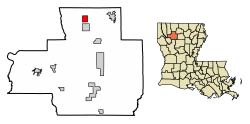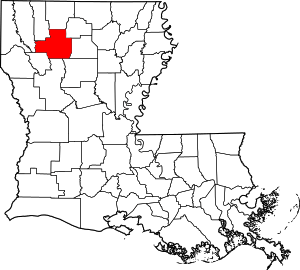Gibsland, Louisiana
Gibsland is a town in Bienville Parish in northern Louisiana, United States. As of the 2010 census, it had a population of 979.[3] The town is best known for its connecting railroads, as the birthplace of the defunct historically black Coleman College, and for the nearby shootings in 1934 of the bandits Bonnie and Clyde.
Gibsland, Louisiana | |
|---|---|
Town | |
Downtown Gibsland | |
 Location of Gibsland in Bienville Parish, Louisiana. | |
.svg.png) Location of Louisiana in the United States | |
| Coordinates: 32°32′34″N 93°03′34″W | |
| Country | United States |
| State | Louisiana |
| Parish | Bienville |
| Government | |
| • Mayor | Ray Ivory, Sr. (No Party) |
| Area | |
| • Total | 2.65 sq mi (6.87 km2) |
| • Land | 2.63 sq mi (6.82 km2) |
| • Water | 0.02 sq mi (0.06 km2) |
| Elevation | 272 ft (83 m) |
| Population (2010) | |
| • Total | 979 |
| • Estimate (2019)[2] | 878 |
| • Density | 333.46/sq mi (128.76/km2) |
| Time zone | UTC-6 |
| • Summer (DST) | UTC-5 (CDT) |
| Area code(s) | 318 |
| FIPS code | 22-28835 |
Gibsland native John McConathy was a champion basketball player at Northwestern State University in Natchitoches, Louisiana, who later was the superintendent for the Bossier Parish School Board, in which capacity he was the guiding force behind the establishment of the $57 million Bossier Parish Community College.[4]
Coleman College
In 1890, with ten students, Coleman Baptist Male and Female College opened its doors to educate the children of nearby freed slaves. The institution produced primarily teachers and preachers.
Supported by the Southern Baptist Church, Coleman College at its peak owned some 100 acres (40 ha), of which ten were devoted to educational purposes. There were eight buildings which included classrooms, auditorium, dormitories, and an administrative building. The college offered a choir, glee club, and intercollegiate athletics. Nicknamed the Bulldogs, Coleman College's chief athletic rival was the historically black Grambling College Tigers in Grambling in Lincoln Parish, subsequently Grambling State University. Enrollment at Coleman reached as high as four hundred in some years. The college closed in Gibsland in 1944. Among its graduates were the first president of Southern University in Baton Rouge, Dr. J. S. Clark, and Ada Bell Lewis Coleman. Ada Coleman was the mother of Mildred Coleman Marks, Geraldine Coleman Gaillord, and the deceased McVicker Monroe Coleman, Jr., and Georgia Coleman McClaron.
Professor Coleman, founder and president of Coleman College, died of injuries sustained in an automobile accident in March 1927 in Jackson, Mississippi. His great-grandson, John R. Marks, III, in 2003 became the mayor of the capital city of Tallahassee, Florida.
Later in 1944, Coleman College re-opened for another decade in Shreveport. By 1946, the trustees had made the last payment on property in the Mooretown community at 3701 Hollywood Avenue, the current location of Winnfield Funeral Home. Decreased enrollment caused the school to close once again in the middle 1950s.
Brief railroad history
First incorporated in 1889, the Louisiana & North West Railroad Company operates 62 miles (100 km) of shortline between Gibsland and McNeil, Arkansas. The LNW interchanges on both ends of the line: with the Union Pacific (former St. Louis Southwestern) in McNeil; and with Kansas City Southern (former MidSouth, ICG) at Gibsland.
For many years the road was well-known among railfans for its unusual stable of F7 "covered wagons"—unusual motive power of choice for a backwoods southern shortline. In the early 1990s, the F units were sold off to various places, gradually replaced by Geeps from various locations. The LNW shops are located at Gibsland, a few hundred yards from one of the busiest interchange diamonds in all of the state. For decades, three different railroads interchanged in Gibsland. The switching activity could get so hectic the daily routine was known among railfans as the "Gibsland Shuffle."
Geography
Gibsland is located in northern Bienville Parish at 32°32′34″N 93°3′13″W (32.542675, -93.053511).[5]
According to the United States Census Bureau, the town has a total area of 2.7 square miles (6.9 km2), of which 0.023 square miles (0.06 km2), or 0.81%, is water.[3]
Demographics
| Historical population | |||
|---|---|---|---|
| Census | Pop. | %± | |
| 1900 | 558 | — | |
| 1910 | 1,065 | 90.9% | |
| 1920 | 798 | −25.1% | |
| 1930 | 1,090 | 36.6% | |
| 1940 | 1,023 | −6.1% | |
| 1950 | 1,085 | 6.1% | |
| 1960 | 1,150 | 6.0% | |
| 1970 | 1,380 | 20.0% | |
| 1980 | 1,354 | −1.9% | |
| 1990 | 1,224 | −9.6% | |
| 2000 | 1,119 | −8.6% | |
| 2010 | 979 | −12.5% | |
| Est. 2019 | 878 | [2] | −10.3% |
| U.S. Decennial Census[6] | |||
As of the census[7] of 2000, there were 1,119 people, 475 households, and 293 families residing in the town. The population density was 422.2 people per square mile (163.0/km2). There were 568 housing units at an average density of 214.3 per square mile (82.8/km2). The racial makeup of the town was 16.26% White, 82.75% African American, 0.36% Asian, 0.36% from other races, and 0.27% from two or more races. Hispanic or Latino of any race were 0.36% of the population.
There were 475 households out of which 29.5% had children under the age of 18 living with them, 32.4% were married couples living together, 23.8% had a female householder with no husband present, and 38.3% were non-families. 36.2% of all households were made up of individuals and 19.4% had someone living alone who was 65 years of age or older. The average household size was 2.34 and the average family size was 3.10.
In the town, the population was spread out with 29.0% under the age of 18, 8.7% from 18 to 24, 25.6% from 25 to 44, 19.3% from 45 to 64, and 17.4% who were 65 years of age or older. The median age was 36 years. For every 100 females, there were 83.4 males. For every 100 females age 18 and over, there were 76.3 males.
The median income for a household in the town was $19,250, and the median income for a family was $22,098. Males had a median income of $25,789 versus $18,958 for females. The per capita income for the town was $12,185. About 27.5% of families and 34.9% of the population were below the poverty line, including 45.3% of those under age 18 and 23.9% of those age 65 or over.
Gallery
 Gibsland welcoming sign: "The Jonquil Capital of Louisiana"
Gibsland welcoming sign: "The Jonquil Capital of Louisiana"- Gibsland Town Hall
 Gibsland Bank and Trust Company also has a branch in nearby Minden.
Gibsland Bank and Trust Company also has a branch in nearby Minden. First United Methodist Church in Gibsland
First United Methodist Church in Gibsland First Baptist Church of Gibsland
First Baptist Church of Gibsland.jpg) The Bonnie and Clyde Ambush Museum in Gibsland
The Bonnie and Clyde Ambush Museum in Gibsland Linton Jay "Boots" Hinton (born January 1, 1934) is the curator of the Bonnie & Clyde Ambush Museum, which opened in Gibsland in 2004. He is the son of Ted Hinton, a deputy sheriff from Dallas, Texas, who was part of the posse that apprehended the bandits Bonnie and Clyde.
Linton Jay "Boots" Hinton (born January 1, 1934) is the curator of the Bonnie & Clyde Ambush Museum, which opened in Gibsland in 2004. He is the son of Ted Hinton, a deputy sheriff from Dallas, Texas, who was part of the posse that apprehended the bandits Bonnie and Clyde.- Located in a former bank building, Gibsland Grill is a well-known area eatery.
Education
The Bienville Parish School Board operates the K-12 Gibsland-Coleman Complex in Gibsland.
Arts and culture
Festivals
The Jonquil Jubilee and Historic and Garden Tour and the Bonnie and Clyde Festival are celebrated annually. The Jonquil Jubilee offers advice to area gardeners from botanists.
Bonnie and Clyde
The Bonnie and Clyde Festival is held in Gibsland in mid-May. It features a staged bank robbery by actors portraying the infamous duo. The festival has been featured on the television program Weird U.S. on the History Channel. Bonnie and Clyde were killed off Louisiana Highway 154, south of Gibsland toward Sailes.
Gibsland is home to the Bonnie and Clyde Ambush Museum located in the former cafe where the outlaws ate their last meal, a breakfast. The museum is owned and operated by Perry Carver. Linton Jay "Boots" Hinton (born January 1, 1934, died December 5, 2016), formerly of Dallas and a son of posse member Ted Hinton managed the museum until his health failed. The museum exhibits also mention the local posse members brought in for jurisdictional reasons, Bienville Parish Sheriff Henderson Jordan (1896–1958) and his chief deputy and successor as sheriff, Prentiss Oakley.
Gibsland-Coleman Alumni
Gibsland-Coleman Alumni Association was organized in 1981. The first reunion was held in July 1981. The Gibsland-Coleman Alumni Association is a non-profit organization of alumni and other individuals who are interested in supporting the organization-mainly providing college scholarships annually to graduating seniors. Chapters are located in Houston, Los Angeles, and Gibsland. The reunion is held in Gibsland annually during the first weekend of July.
Government officials
The present Mayor of Gibsland is Ronnie Terry Wilson. Mr. Wilson qualified to run for mayor in the 2014 elections, and was unopposed. Mr. Wilson assumed the position of Mayor in January, 2015, and will serve a four-year term. There are five Aldermen who serve on the Council of the Town of Gibsland. Patricia Durham, Julius Pearson, Jeannie Richardson, and Eddie Thompson all qualified to run in the 2014 election, and was unopposed; therefore, they assumed their positions in January, 2015, and Alvin Pearson, Jr., who was previously on the Council, qualified to run again in the 2014 election, and was unopposed; and he too assumed his position in January, 2015 as well. The Council will serve a four-year term.
Pinkie C. Wilkerson represented Gibsland in the Louisiana House of Representatives from 1992 until her death in an automobile accident in 2000. A Gibsland street bears her name.
Mayor Fletcher Sutton of Gibsland won a special election in 1956 to the Louisiana House from Bienville Parish to succeed Lorris M. Wimberly of Arcadia, who stepped down to become director of the Louisiana Department of Public Works. Sutton defeated C. L. McCrary, an Arcadia businessman who rebounded to claim the seat for a full term beginning in 1960.
References
- "2019 U.S. Gazetteer Files". United States Census Bureau. Retrieved July 25, 2020.
- "Population and Housing Unit Estimates". United States Census Bureau. May 24, 2020. Retrieved May 27, 2020.
- "Geographic Identifiers: 2010 Demographic Profile Data (G001): Gibsland town, Louisiana". U.S. Census Bureau, American Factfinder. Archived from the original on February 12, 2020. Retrieved December 2, 2013.
- Scott Ferrell. "NSU hoops legend John McConathy dies at 86". The Shreveport Times. Retrieved April 19, 2016.
- "US Gazetteer files: 2010, 2000, and 1990". United States Census Bureau. 2011-02-12. Retrieved 2011-04-23.
- "Census of Population and Housing". Census.gov. Retrieved June 4, 2015.
- "U.S. Census website". United States Census Bureau. Retrieved 2008-01-31.
| Wikimedia Commons has media related to Gibsland, Louisiana. |
